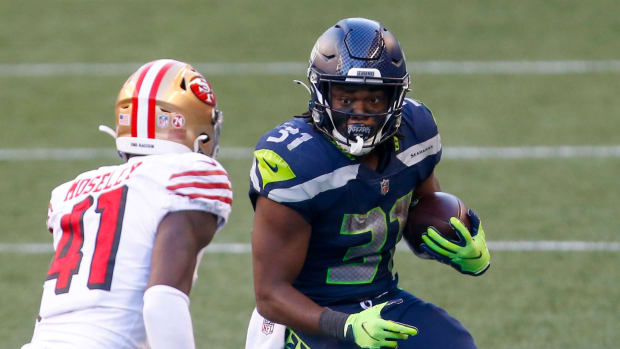Seahawks Offseason Profile: Poona Ford
Following a strong finish to his rookie campaign, the Seahawks were hopeful defensive tackle Poona Ford would be able to take the next step forward and emerge as a reliable starter in 2019.
With teammate Jarran Reed suspended for the first six games of the regular season, Ford needed to grow up quickly and make an immediate impact in the starting lineup. Luckily, the third-year pro did exactly that, filling in admirably until Reed returned.
Let’s revisit some of the good and the bad from Ford’s sophomore campaign, along with a prediction of how next season may play out for him as he heads toward restricted free agency in 2021.
What Went Right
After making just one start in 2018, Ford’s role within Seattle’s defense increased significantly this past season, as he started in 14 of his 15 games played during the regular season.
Over his 506 defensive snaps (47 percent of the total snaps), the 5-foot-11 defensive tackle produced career-highs in total tackles (32), solo tackles (21), tackles for loss (five), and the youngster even recorded his first sack (0.5) as well.
Even though Reed returned from his suspension in Week 7, Ford’s impressive results through the first six weeks of the season kept him in a starting role for the rest of the campaign - allowing him to create further chaos against opposing teams. In particular, the former undrafted free agent out of Texas was involved in a pair of impactful plays during Seattle’s Week 10 showdown against San Francisco and against Carolina in Week 15.
After Jadeveon Clowney stripped the football away from 49ers’ quarterback Jimmy Garoppolo, Ford was able to recover the turnover just outside the red zone. As a result, the Seahawks were able to score a touchdown just four plays later, extending their lead to 21-10 late in the third quarter.
Against Carolina, the 24-year old Ford played a key part in helping to force an interception just over halfway through the third quarter. Following the run stuffer’s pass deflection at the scrimmage line, linebacker K.J. Wright was able to intercept the ball and return it up to the 50-yard line.
Along with his impressive results during the regular season, with veteran Al Woods suspended starting in Week 16, Ford played a big role in the postseason. Over Seattle’s two playoff matchups, he generated six total tackles, five solo tackles, one tackle for loss, and a hurry against Packers quarterback Aaron Rodgers.
What Went Wrong
Despite the amount of progress Ford made this past season, the former Texas product still has a ton of work to do as a pass rusher during the 2020 campaign.
Even though the former Longhorn recorded his first career sack and increased his quarterback pressures, hits, and hurries in 2019, his pass rushing metrics still ranked as some of the worst in the league for his position.
Among all defensive linemen with at least 200 rushing attempts, Ford finished tied with the seventh-fewest sacks (0.5) and quarterback hurries (six), the 12th-fewest total pressures (10), and the 16th-lowest pressure rate (4.2 percent), according to Sports-Info-Solutions.com.
In addition to Ford’s woes in the pass rush, the South Carolina native also struggled with his tackling at times during his first year as a starter. While his totals weren’t a major concern, they’ll likely need to be monitored heading into next season.
During his rookie campaign, Ford didn’t record a single missed tackle over his 231 defensive snaps. Unfortunately, he couldn’t replicate that same effectiveness in 2019 - recording five missed tackles.
2020 Outlook
With Woods and Quinton Jefferson departing during free agency this spring, Ford will undoubtedly return to his starting job alongside Reed next season.
Since Seattle hasn’t added much depth up the middle of their defensive line this offseason, Ford should receive even more playing time during the 2020 campaign. It would be surprising if he doesn't play well above 50 percent of the team's snaps.
In comparison to Ford’s first two seasons in the league, there have been 32 other defensive tackles to start in at least 15 regular season games and produce a minimum of 53 total tackles, 34 solo tackles, eight tackles for loss, five quarterback hits, one pass deflection, and 0.5 sacks through their first two seasons in the NFL.
Among the names listed above, only 11 of them (Ndamukong Suh, Barry Cofield, Jurrell Casey, Marcell Dareus, DeForest Buckner, Haloti Ngata, Geno Atkins, Stephon Tuitt, Javon Hargrave, Aaron Donald, and Chandler Jones) produced at least 30 solo tackles, 20 solo tackles, five tackles for loss, five quarterback hits, one sack, and one pass deflection during their third seasons in the league. Several of those players were outstanding pass rushers early in their careers, holding a significant advantage over Ford.
But despite this sample size, there’s a very good chance Ford will be able to improve upon his production, particularly as a pass rusher. Much like Reed did in 2018, he could take a major step forward in year three generating pressure on opposing quarterbacks, which would dramatically increase his value.
If Ford can stay healthy for the third consecutive season, then he could be poised for a breakout performance during his third season in the league. Since he’s slated to become a restricted free agent next spring, a strong performance in 2020 could earn him a lucrative deal to remain with the Seahawks.




